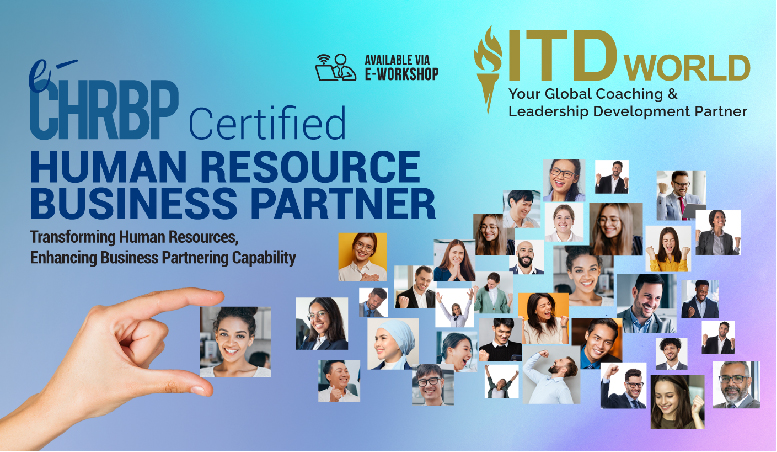Given the rapidly evolving landscape of modern business, Human Resource functions have transcended their traditional administrative boundaries to become strategic partners in achieving organizational goals. Central to this transformation is the role of the Human Resource Business Partner (HRBP), a dynamic and pivotal figure that acts as a bridge connecting HR and overall business strategy. HRBPs are not merely HR practitioners – they are strategic influencers, change agents, and a collaborative force that ensures HR practices align seamlessly with the overarching objectives of the organization.
(by Jonathan M. Pham)
What is HR Business Partner (HRBP)?
HR Business Partners (HRBPs) – also known by other names such as Human Resources Partners, Human Capital Partners, Human Resource Partners, etc. – are HR professionals who serve to connect an organization’s people strategy with its broader business goals. Unlike traditional HR roles that often revolve around operational and administrative tasks, the HRBP is all about long-term planning and strategy. Their primary mission is to ensure that the organization’s people initiatives are in perfect harmony with the overarching business strategy.
In the role of an HRBP, the focus shifts from engaging with employees directly to serving as a trusted consultant and advisor to senior leadership. They play a pivotal role in shaping the people-related decisions and actions that will impact the company’s future. As such, the Human Resource Business Partner role represents a fundamental shift in HR’s contribution, moving it beyond a support function to a strategic partner that has a profound impact on an organization’s ability to thrive in a competitive environment.
History of the HRBP Model
The concept of the Human Resource Business Partner (HRBP) model represents a pivotal shift in the history of human resources, redefining the role of HR from a predominantly administrative function to a strategic powerhouse within organizations. Its roots can be traced back to the late 1980s and early 1990s – when businesses began to realize the strategic significance of their human resources.
The visionary who laid the foundation for the HRBP model was renowned professor and consultant Dave Ulrich. In his groundbreaking 1997 book, “Human Resource Champions,” Ulrich advocated that the HR function should encompass four key roles:
- Strategic partner
- Administrative expert
- Employee champion, and
- Change agent.
Among these roles, the strategic partner emerged as the most critical and innovative. It called for HR professionals to become embedded within business units, fostering a symbiotic relationship between HR practices and business goals.
The 2000s witnessed a surge in the adoption of the HRBP model, as more companies sought to revamp their HR functions, transitioning from administrative support centers to strategic allies in the pursuit of business objectives. Over the years, it has been constantly updated in response to changing business environments and the evolving expectations placed upon HR professionals.
Several key changes and trends have influenced this evolution:
- Technological advancements: The advent of technologies like cloud computing, artificial intelligence, and data analytics has empowered HR to streamline its processes, enhance its capabilities, and deliver more personalized and customized services.
- Complex business landscape: Factors such as globalization, digitalization, disruption, and heightened competition have necessitated HR to be more agile, adaptable, and innovative in responding to the dynamic needs and demands of the organization and its stakeholders.
- Talent as a competitive advantage: Organizations have recognized talent as a vital source of competitive advantage, driving HR to attract, develop, engage, and retain top-tier talent.
- Changing expectations: Employees and managers increasingly seek more involvement, empowerment, and feedback from HR, alongside greater transparency, accountability, and collaboration.
- Shifts in organizational structure: The transformation from hierarchical, function-based structures to networked and team-based structures has required HR to work more closely with business leaders and managers, as well as across different units and functions.
These transformative forces have led to various adaptations in the HRBP model, including:
- Expanding the role of the strategic partner: Beyond aligning HR practices with business goals, HRBPs are now expected to influence and shape the business strategy and culture, propelling HR into a central role in organizational decision-making.
- Emphasizing data-driven decision-making: Data and evidence-based practices have become paramount in HR, ensuring that all actions and initiatives are grounded in facts, insights, and outcomes.
- Skill development: HRBPs are now expected to seriously hone their skills and competencies, including business acumen, analytical prowess, consulting abilities, relationship-building skills, change management acumen, and leadership capabilities.
- Balance in HR Roles: Rather than focusing on one role at the expense of others, HRBPs are encouraged to take a more balanced and integrated approach to the four HR roles, ensuring that being an administrative expert does not overshadow the employee champion – or that being a change agent complements the strategic partner role.
Human Resources Business Partner Responsibilities
-
Strategic partner & planner
As mentioned, Human Resource Business Partners (HRBPs) serve to form the intersection of HR and business strategy. Collaborating closely with business leaders, they translate strategic objectives into actionable HR plans. This includes:
- Forecasting future talent needs
- Advising on talent management strategies to attract, develop, and retain top talent, and
- Ensuring HR initiatives align seamlessly with business goals.
HRBPs play a critical role in managing employee performance, from setting goals to conducting performance reviews and providing constructive feedback. They also contribute to the development and execution of strategies aimed at enhancing the organization’s structure, culture, and overall effectiveness.
-
HR expert
As HR professionals, HRBPs are responsible for developing and implementing effective recruitment strategies to source, select, and hire the right talent for the organization. They provide invaluable guidance on complex HR issues, ranging from compliance and compensation to employee relations.
HRBPs also take charge of designing and managing compensation packages, benefits, and incentives. Staying abreast of legal and regulatory changes that affect HR practices is another key responsibility, as is designing and implementing HR programs and policies. Succession planning is another cornerstone of their role, ensuring the continuity and development of talent within the organization.
-
Employee champion
HRBPs act as mediators who help resolve workplace conflicts and foster a positive, engaging work environment that promotes holistic well-being. Timely and equitable resolution of employee concerns and grievances is part of their purview. By facilitating communication and collaboration between employees and management, HRBPs play a critical role in promoting diversity and inclusion within the workplace.
-
Change agent
When it comes to managing change within an organization, HRBPs don multiple hats. They are in charge of driving change initiatives that align with both business goals and HR strategies – ensuring that changes are managed effectively, accounting for employee needs and organizational culture.
-
Data analyst
The data-driven nature of the modern HR landscape requires HRBPs to collect and analyze HR data to identify trends and patterns. These insights are then used to inform decision-making, optimize workforce performance, and improve HR practices.
HR Business Partners often develop HR metrics and dashboards to track progress and measure impact. They also manage HR systems, software, and tools to streamline processes, including payroll, time tracking, and HRIS (Human Resources Information System).
-
Relationship builder
Effective relationship building is a hallmark of an HRBP. They establish strong relationships with key stakeholders, including business leaders, managers, and employees. Trust and credibility are built through effective communication and collaboration, and this trust is leveraged to influence decision-making and advocate for HR initiatives that support business goals.
Read more: Stakeholder Management – A Leader’s Engagement Playbook
-
Coach & Mentor
HRBPs play a crucial role in employee development by providing coaching and mentoring for team members to refine their skills and visualize their career goals. Additionally, they help identify and nurture high-potential employees for future leadership roles and enhance the workforce’s skills through training and learning & development programs.
For those who would like to learn more about the goals of HRBP – what one does on a daily basis, you may want to check out this sample job description from the SHRM.
Read more: HR as Business Partner or Change Champion? – by William J. Rothwell

HR Business Partner vs HR Manager & HR Generalist
While HRBPs, HR Managers, and HR Generalists all contribute to the HR function, they occupy distinct niches within the ecosystem, each catering to a unique set of responsibilities and demands.
Scope & Focus:
- HR Business Partner: The HRBP’s primary focus is strategic and long-term planning. They are less concerned with day-to-day operational and administrative tasks. Instead, their purview is to align HR practices with the broader business objectives, ensuring that strategies are tailored to support the organization’s long-term success.
- HR Manager: The role of an HR Manager often strikes a balance between strategic and operational aspects of HR. The specific emphasis may vary depending on the size and needs of the organization. In smaller companies, an HR Manager may be more hands-on with operational tasks, while in larger enterprises, they tend to focus more on strategic HR planning.
- HR Generalist: HR Generalists, in contrast, are primarily engaged in operational and administrative tasks. They deal with the day-to-day aspects of HR, such as handling employee inquiries, managing payroll, and ensuring compliance with HR policies and procedures. While they may have some strategic input, their core responsibilities revolve around operational matters.
Level & Type of Interaction with the business:
- HR Business Partner: HRBPs operate on a senior level and maintain close collaboration with business leaders and managers. Their interactions primarily involve working alongside leadership to develop and implement HR strategies that align with the business’s overall goals. They act as strategic consultants, offering solutions and recommendations that drive business success.
- HR Manager: HR Managers bridge the gap between business leaders and employees. They interact with both sides, ensuring that HR policies and practices are communicated and applied effectively. Their role involves serving as service providers to the business while also enforcing HR policies to maintain compliance and consistency.
- HR Generalist: HR Generalists predominantly work directly with employees. They are often the first point of contact for employees seeking HR support and guidance. Their interactions are people-centric, covering a wide range of HR matters, from employee relations to benefits administration, and often involve providing hands-on assistance.
Skills & Competencies required:
- HR Business Partner: HRBPs need to possess a diverse skill set, including strong business acumen, analytical abilities, consulting skills, relationship-building skills, change management expertise, and leadership capabilities. They must be adept at understanding the business landscape and translating it into HR strategies that drive organizational success.
- HR Manager: HR Managers require a solid understanding of HR laws and regulations, along with performance management skills to assess and improve employee performance. Effective communication, problem-solving, and people management skills are essential, as they often serve as the link between employees and leadership.
- HR Generalist: HR Generalists must have a general knowledge of all aspects of HR, ranging from recruitment and training to compensation, benefits, and employee relations. Organizational skills, time management, and customer service skills are crucial, as they need to juggle a variety of tasks and handle employee inquiries promptly.
| Aspect | HR Business Partner | HR Manager | HR Generalist |
|---|---|---|---|
| Scope & Focus | Strategic and long-term planning | Balance between strategic and operational | Operational and administrative tasks |
| Align HR practices with business goals | Vary with organization size and needs | Day-to-day HR responsibilities | |
| Level & Type of Interaction | Senior-level, collaboration with leaders | Bridge between business leaders and staff | Direct interaction with employees |
| Strategic consultant, offers solutions | Enforce HR policies, maintain compliance | First point of contact for HR support | |
| Skills & Competencies | Business acumen, consulting, leadership | HR laws, performance management | General HR knowledge, customer service |
| Analytical, relationship-building | Communication, people management | Organizational skills, time management | |
| Change management, leadership | Problem-solving |
Benefits of HRBPs
Why choose an HR business partner? Simple: They are catalysts for strategic growth, cultural transformation, and financial success. In fact, employing an HRBP has been proven to bring about a multitude of advantages, namely:
- Strategic alignment
One primary benefit is the profound strategic alignment they bring to an organization. HRBPs ensure that HR initiatives are not merely administrative tasks, but are meticulously crafted to contribute directly to the company’s success. By forging a deep connection between HR practices and business goals, they enable an organization to harness its human capital as a powerful strategic asset.
- Improved morale
Studies have demonstrated that organizations with robust HRBP capabilities tend to enjoy higher employee engagement and lower turnover rates. According to Deloitte, companies with strong HRBP capabilities experience a 78% employee engagement rate, significantly surpassing the 58% rate seen in those with weaker HRBP capabilities. Furthermore, they also report lower turnover rates (13.2% – compared to 16.4% in their counterparts).
In addition, organizations with high-quality HRBPs can generate up to 3.5 times the revenue growth and 2.1 times the profit margin compared to their peers.
- Competitive advantage
A study by McKinsey has revealed that organizations that embrace an agile HR model, empowering HRBPs to act as strategic partners and change agents, are equipped to achieve remarkable outcomes. They report up to 55% higher employee net promoter scores, an 18% boost in customer satisfaction scores, and a 30% reduction in time to market compared to their competitors. This not only translates into better relationships with both employees and customers – but also positions the organization for faster adaptation in a rapidly changing market.
- Reduced operational costs
HRBPs also serve as cost-saving champions for businesses. They can identify and implement cost-effective HR solutions, making HR operations more efficient and streamlined.
Additionally, employee turnover is often a substantial cost for businesses, incurring expenses related to recruitment, training, and lost productivity. HRBPs’ ability to foster a positive work environment and address employee concerns efficiently helps in mitigating these costs.

Pros and Cons of the HRBP Model
The HR Business Partner (HRBP) model has been gaining recognition as a powerful approach to elevate the role of HR in organizations, aligning people strategies with business objectives. While it brings numerous advantages to the table, it’s not without its challenges.
Pros:
- Building a strong and adaptive workforce: HRBPs contribute to building a resilient and adaptable workforce, capable of responding to changing market conditions and evolving customer demands. This adaptability is a strategic asset that aids organizations in unleashing innovation capabilities and maintaining a competitive edge.
- Enhancing organizational performance: As mentioned, HRBPs play a pivotal role in attracting, developing, engaging, and retaining top talent – which helps drive organizational productivity and ultimately contributes to the bottom line.
- Proactive problem-solving: These people function as trusted advisors to business leaders. Their expertise enables them to provide guidance on HR matters (e.g. laws, regulations, workplace conflicts, etc.) and anticipate potential issues before they escalate – hence allowing organizations to avoid costly problems, maintain a harmonious work environment, and seize opportunities.
- Fostering a positive and inclusive culture: HRBPs are instrumental in nurturing a culture that supports employee well-being, satisfaction, and engagement. They aid in promoting diversity and inclusion, creating a workplace that is not only productive but also fulfilling for employees.
Cons:
- Resource allocation: Implementing the HRBP model may require significant time and resources to train and develop HR professionals to meet the expectations and demands of business leaders and managers. This may prove to be challenging for smaller businesses or those with limited HR resources.
- Role clarity: Another major weakness is the risk of role ambiguity or conflict between HR professionals, business leaders, or managers – particularly if they hold differing views or interests on HR matters. If left unresolved, the issue may escalate to the point of a loss of focus or consistency in HR policies and procedures.
- Buy-in from management: The success of the HRBP model hinges on strong support from senior management. Many times, organizations will face resistance or skepticism from stakeholders who do not fully understand or appreciate the value or role of HR professionals in a strategic capacity.
- Measurement of impact: Quantifying the impact of HRBPs’ contributions is not an easy task, as their work often involves intangible factors like employee engagement and culture. For organizations that rely heavily on quantifiable metrics for performance evaluation, it is often difficult to demonstrate the ROI (Return on Investment) of HRBPs’ efforts.
Given the various strengths and weaknesses above, organizations need to take careful consideration in order to successfully implement the model and reap its benefits.
HR Business Partner Metrics
Below are some common HR Business Partner performance metrics to evaluate their effectiveness:
- Potential: Measuring the ability and motivation of employees to succeed in senior positions in the organization. Tools such as the 9-box matrix or the talent pipeline may help gauge employee performance and potential based on current contributions and future growth capability.
- Number of high potentials identified for each critical role: Assessing the size and quality of the talent pool for each key position in the organization.
- Percentage of critical positions filled internally: Reflecting the effectiveness of the succession plan in filling key positions with qualified internal candidates. It is calculated by dividing the number of critical positions filled internally by the total number of critical positions in the organization.
- Risk of loss: The probability of losing key employees or candidates due to various factors such as retirement, resignation, disability, or death.
- High potential turnover: Measuring the retention rate of high potential employees or candidates. It is calculated by dividing the number of high potentials who left the organization by the total number of high potentials in the organization.
- Bench strength: Demonstrating how well the organization can fill its key positions with qualified internal candidates. It is the result of dividing the number of potential successors by the number of key positions in the organization.
- Career path ratio: How many career paths are available for each key position in the organization.
- Development activities: How many learning opportunities are provided for each candidate in the succession plan.
- Pipeline utilization: How many candidates in the succession plan are actually promoted or moved to new roles.
Aside, there are other operational metrics that may also be taken into consideration – such as time to fill, cost per hire, quality of hire, and stakeholder and employee satisfaction.
Human Resource Business Partner Skills & Qualities
Great HRBPs play a crucial role in ensuring that the organization’s most valuable asset – its people – is fully engaged and contributing to overall success. To excel in this role, a dynamic combination of competencies is required – some of them are:
- Business acumen
A great HR Business Partner possesses an intimate understanding of the organization’s vision, mission, values, goals, challenges, and opportunities. They comprehend how HR can strategically support these elements. Moreover, they excel in analyzing data and metrics to inform decisions, measure outcomes, and gauge the impact of HR initiatives.
- HR expertise
HRBPs must be well-versed in all aspects of HR, including talent management, compensation and benefits, employee relations, and compliance. This deep knowledge enables them to provide expert advice and guidance on a wide range of HR issues, making them trusted advisors to business leaders.
- Interpersonal skills
Good HRBPs are excellent communicators, both verbally and in writing. They skillfully build strong relationships with business leaders, managers, and employees, fostering trust, openness, and collaboration throughout the organization.
- Problem-solving & analytical skills
HRBPs are adept at identifying and solving complex HR problems. They skillfully collect and analyze data, drawing insights that enable them to make informed recommendations and decisions.
- Consulting skills
Another notable characteristic is the ability to effectively communicate with diverse stakeholders, understand their unique needs and expectations, and provide tailored solutions/ recommendations that drive change within the organization.
- Change management skills
HRBPs anticipate, plan, implement, and manage change initiatives that affect the organization’s people, processes, or culture. They are instrumental in ensuring that the transition is smooth and positively impacts the workforce.
- Leadership skills
A great HRBP is not just a follower but a leader – in that they inspire, motivate, coach, mentor, and develop others. Qualities such as integrity, accountability, and professionalism are embodied within their interactions and decisions.
- Employee advocacy
HRBPs are passionate advocates for employee well-being. They are approachable, empathetic, and fair in their dealings with employees.
- Data literacy
Being comfortable working with data and analytics is a crucial requirement for business partners. HRBPs are skilled at collecting, analyzing, and interpreting HR data – based on which they may come up with informed people development strategies.

HRBP Best Practices
-
Understand the business
A proficient HR Business Partner should possess a deep understanding of the organization’s vision, mission, values, goals, challenges, and opportunities. They must also grasp how HR can strategically support these elements – and be skilled in analyzing data to inform decisions and gauge the impact of HR initiatives.
Example:
Organization: A tech startup aiming to revolutionize the online education industry with its innovative learning platform.
Vision: To become the leading provider of personalized and accessible online education worldwide.
Mission: To empower learners of all ages and backgrounds to achieve their educational goals through engaging, interactive, and technology-driven learning experiences.
Values: Innovation, inclusivity, accessibility, collaboration, and lifelong learning.
Goals:
- Increase user base by 50% within the next year.
- Expand course offerings to cover a wider range of subjects and skill levels.
- Enhance the platform’s user experience and accessibility features.
Challenges:
- Attracting and retaining top talent in a competitive tech market.
- Maintaining a strong company culture amidst rapid growth.
- Adapting to evolving educational trends and technologies.
Opportunities:
- Partnering with educational institutions and organizations to expand reach.
- Leveraging data analytics to personalize learning experiences.
- Exploring new technologies like AI and virtual reality to enhance learning.
HRBP’s strategic support:
- Develop a comprehensive talent acquisition strategy to attract and retain top tech talent, focusing on diversity and inclusion initiatives.
- Implement a robust onboarding and training program to integrate new hires into the company culture and equip them with the necessary skills.
- Design and implement employee engagement programs that foster collaboration, recognition, and a sense of belonging.
- Conduct regular employee surveys and focus groups to gather feedback and identify areas for improvement in company culture and employee satisfaction.
- Partner with the product development team to incorporate HR insights into the platform’s design, ensuring accessibility and user-friendly features.
- Analyze HR data to identify trends in employee performance, engagement, and retention, using these insights to inform strategic decisions.
- Stay abreast of emerging educational technologies and trends, proposing innovative ways to integrate them into the platform and enhance learning experiences.
-
Build relationships
Establishing trust and rapport with business leaders, managers, employees, and fellow HR professionals is paramount for the success of HRBPs. They must work collaboratively across different units and functions, fostering a unified organizational culture. Effective communication with diverse stakeholders, an understanding of their unique needs, and the ability to provide solutions and influence change are all critical requirements.
-
Be agile
HRBPs need to be adept at anticipating, planning, implementing, and managing change initiatives that influence the organization’s people, processes, or culture. They should also demonstrate adaptability in the face of changing market conditions and customer demands. Embracing innovation and growth alongside the business is key to success.
Example:
A retail company with a network of brick-and-mortar stores is facing increasing competition from online retailers. To adapt to the changing market landscape, the company decides to implement a digital transformation strategy, including a new e-commerce platform and a shift towards omnichannel retail experiences.
HRBP’s Role:
- Anticipate: Proactively identifies the potential impact of the digital transformation on the workforce, recognizing the need for new skills, training, and changes in work processes.
- Plan: Collaborates with business leaders to develop a comprehensive change management plan that addresses the people, processes, and cultural aspects of the transformation.
- Implement: Leads the implementation of the change plan, ensuring effective communication, training, and support for employees throughout the transition.
- Manage: Monitors the progress of the change initiative, gathers feedback from employees, and makes adjustments as needed to ensure a smooth and successful implementation.
- Adaptability: Demonstrates adaptability by staying up-to-date on emerging digital trends, identifying new skills required for the e-commerce shift, and proposing innovative ways to attract and retain talent with the necessary expertise.
- Embracing innovation: Embraces innovation by proposing new HR initiatives that align with the digital transformation strategy, such as implementing online training modules for employees, developing a digital onboarding process, and creating a virtual collaboration platform for remote teams.
- Growth Mindset: Encourages a growth mindset within the organization, promoting continuous learning and development opportunities for employees to adapt to the changing demands of the digital landscape.
Read more: Agility Coaching – Navigating Change & Fueling Business Success
-
Be committed to continuous learning
Staying current with the latest HR trends, legal and regulatory changes, and best practices is essential. Being committed to continuous learning allows one to expand their knowledge base, thereby enabling them to offer the most relevant and effective advice.
-
Maintain ethical conduct
Upholding the highest standards of integrity and ethics in all interactions and decision-making is a fundamental best practice for HRBPs. This entails being discreet, fair, and trustworthy in handling sensitive information and employee matters. Integrity is the bedrock upon which trust is built.
How to Become an HR Business Partner
Becoming an HR Business Partner (HRBP) is an exciting journey that combines education, experience, and a passion for both people and business. Here’s a comprehensive guide for those who would like to tread this professional path:
- Get a bachelor’s degree
Start by earning a bachelor’s degree in HR or a related field, such as business management. This educational foundation will provide you with a fundamental understanding of various HR aspects, including recruitment, training, compensation, benefits, and employee relations.
- Gain relevant work experience
HRBPs need substantial HR experience, preferably in diverse functions or domains. Begin your career as an HR administrator, assistant, coordinator, officer, or generalist – then gradually progress to more senior or specialized roles. Additionally, seek opportunities to work on strategic projects involving collaboration with business leaders, as this experience is invaluable for honing your strategic decision-making capabilities.
- Get an HR Business Partner certification
While not mandatory, obtaining an HR Business Partner qualification should greatly enhance your competence and credibility. Certification options vary based on your experience and education level. Examples include the SHRM Certified Professional (SHRM-CP), SHRM Senior Certified Professional (SHRM-SCP), and ITD World’s Certified Human Resource Business Partner (CHRBP).
- Develop core competencies
As an HRBP, you must master the four core HR competencies (business acumen, data literacy, digital dexterity, and people advocacy). Additionally, it is recommended to acquire functional competencies, as well as to hone analytical, consulting, relationship-building, change management, and leadership skills through formal education, online courses, workshops, webinars, and ongoing learning opportunities.
- Develop strategic skills
A deep understanding of business acumen may be acquired by delving into financial statements, industry trends, and competitive analysis. Strengthen your problem-solving and analytical abilities to address HR challenges using data-driven solutions.
- Network & learn from others
Connect with other HRBPs to expand your knowledge, insights, and career opportunities. For this purpose, we recommend you join professional associations/ communities such as SHRM and attend relevant events/ conferences. In addition, make sure to utilize platforms like LinkedIn to connect with experienced professionals who can provide guidance and mentorship.
- Continuous learning
To stay informed about emerging HR trends, legal/ regulatory changes, and best practices, you should strive to attend workshops, webinars, and conferences. Read industry publications, subscribe to HR newsletters, and pursue continuous learning opportunities through online courses, certifications, and professional development programs.
Read more: HR Competency Model Analysis – Elevating HR Practices for Success

FAQs
Why should I consider a career as an HRBP?
A career as an HR Business Partner (HRBP) offers numerous benefits and rewards for individuals who are passionate about aligning people’s strategies with business objectives – including:
- Impactful role: Directly shape organizational success by enhancing employee engagement and productivity.
- Strategic influence: Act as a strategic advisor, shaping culture and talent management strategies.
- Variety & challenge: Tackle diverse HR challenges, requiring adaptability and problem-solving skills.
- Career growth: Enjoy clear career progression, from senior HRBP to leadership roles or specializations.
- Rewarding outcomes: Witness the direct impact of your work on employee well-being and business goals.
- Competitive compensation: Receive competitive salaries, bonuses, and benefits.
- High demand: Benefit from a positive job outlook as businesses value HRBP roles.
Is HR Business Partner a good job?
HRBP can be considered a good job because it offers a strategic role, a diverse range of tasks, a competitive earning, and various benefits. In terms of salary, data from Glassdoor revealed that the total pay range is from 81-127K/year – across all industries. For Malaysia, it’s about MYR 18-22K per month.
(Note: Data is subject to change as time passes by)
Is being an HRBP hard?
HRBPs are required to balance strategic vision with day-to-day HR tasks, manage diverse stakeholder expectations, handle sensitive matters with discretion, adapt to constant change, measure HR impact, and stay updated on evolving trends. While it’s demanding, the rewards of shaping organizational success, creating positive work environments, and supporting employee growth make it highly fulfilling.
What is a typical day for an HRBP?
Here’s a general overview of how an HR Business Partner’s typical day might be:
- Start with email and message check, prioritizing tasks.
- Join a senior leadership meeting, offering HR insights and solutions.
- Coach a line manager on performance issue resolution.
- Review talent pipeline and succession planning.
- Facilitate a feedback focus group for training evaluation.
- Engage in HR-related webinars or podcasts.
- Conclude by updating HR systems, sharing key outcomes, and setting goals for the next day.
What are some HRBP interview questions?
General questions:
- Why are you interested in a career as an HR Business Partner?
- What do you see as the key responsibilities of an HRBP?
- How would you describe your approach to partnering with business leaders?
- What experience do you have in aligning HR initiatives with business objectives?
- How would you measure the effectiveness of HR programs and initiatives?
- What are your strengths and weaknesses as an HR professional?
- How do you stay up-to-date on HR trends and best practices?
- What is your experience in handling sensitive employee relations issues?
- How would you approach a situation where there is a conflict between business needs and employee well-being?
- What is your leadership style and how would you motivate and engage employees?
Behavioral interview questions:
- Tell me about a time when you successfully partnered with business leaders to implement a strategic HR initiative.
- Describe a situation where you used data to identify and address an HR challenge.
- Share an example of how you have influenced a business decision by providing HR insights.
- How have you contributed to improving employee engagement or retention in your previous roles?
- Recall a time when you had to handle a difficult employee relations issue and how you resolved it.
- Describe a situation where you had to balance competing priorities from different stakeholders.
- Give an example of how you have coached or mentored an employee to achieve their career goals.
- How have you adapted your HR approach to respond to changes in the business environment?
- Tell me about a time when you had to communicate a sensitive HR matter to employees or management.
- Share an example of how you have demonstrated a strong business acumen in your HR work.
Where can I find HR Business Partner jobs?
There are numerous online platforms and resources where you can find HR Business Partner (HRBP) jobs, including remote opportunities. Here are some of the most popular options:
- Indeed: A vast job board with global listings. Filter by location, salary, and more. Apply directly or upload your resume.
- Glassdoor: Offers company insights, reviews, and job postings. Compare employers and access company information.
- ZipRecruiter: Connects job seekers and employers using smart matching technology. Create a profile, receive job alerts, and apply easily.
- FlexJobs: Specializes in flexible and remote work. Explore HR and other job categories, plus access career resources.
- LinkedIn: Leverage your professional network to find HRBP roles. Connect, follow companies, and apply directly on the platform.
What is an HR Business Partner Career Path?
The HR Business Partner career path generally advances as follows:
HR Business Partner ➡️ Senior HR Business Partner ➡️ Head HR Business Partner ➡️ HR Director ➡️ Chief Human Resources Officer.
Additionally, HRBPs can explore various career transitions and related titles both within and beyond their industry, including positions such as:
- Talent Acquisition Specialist
- Business Partner
- Employee Relations Specialist
- Employee Relations Manager
- Human Resources Analyst
- Talent Acquisition Partner
- etc.
What are some HR Business Partner tools & technologies?
HR Business Partners (HRBPs) utilize a wide range of technologies to streamline their work, enhance productivity, and make data-driven decisions. These tools can be categorized into several key areas:
- Human resources software: Tools like BambooHR, Paycor, and Rippling streamline employee record management, covering payroll, benefits, performance, and training.
- Augmented writing tools: Tools like TapRecruit, Gender Decoder for Job Ads, and Textio use AI to enhance language and tone in written materials, such as job ads and emails.
- Preselection tools: Platforms like Harver, Kandio, and McQuaig assist HRBPs in screening and assessing candidates, reducing bias, saving time, and improving hiring quality.
- Onboarding tools: Solutions like Talmundo, Enboarder, and Click Boarding automate onboarding processes, improving the employee experience, retention, and productivity.
- Productivity tools: ClickUp, Asana, and Trello all help HRBPs organize tasks, collaborate, and manage time effectively.
- HR analytics/ data visualization tools: Platforms like Tableau, Power BI, and Qlik Sense transform HR data into interactive dashboards and reports for data-driven decision-making.
Read more: HR Transformation – A Step-by-Step Guide to Building a Future-Proof Workforce
Discover ITD World’s Human Resources Business Partner Certification
ITD World’s Certified Human Resource Business Partner (CHRBP) program is designed and delivered by seasoned HRD expert KC Yan. The course brings a unique blend of knowledge, experience, and practical insights into the HRBP role – as such, it is a valuable asset for HR professionals seeking to take on/ excel in this position.
Our HRBP certification training program covers a wide spectrum of competencies and skills, ensuring that participants gain a well-rounded understanding of the role. Upon successful completion of the course, participants will receive an official certification from ITD World, which is widely recognized in the HR industry.
Contact ITD World today for a FREE consultation!
Other resources you might be interested in:
- Talent Transformation: Building a High-performing, Future-ready Workforce
- Business Process Transformation: Strategies for Success
- Executive Coaching for Sustainable Results
- Performance Coaching: Unlock People’s Greatness
- Inspirational Leadership: Igniting Passion & Purpose in Your Team


